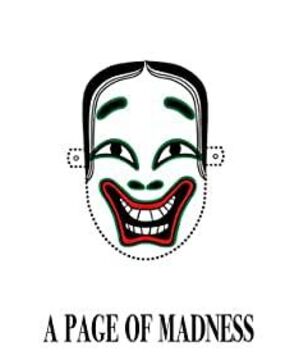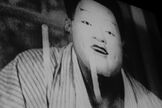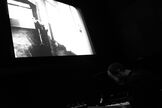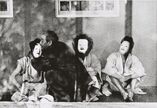The film "Crazy Page" is claimed to be the first work of the "New Sensation Film League". The film was adapted from Kawabata Yasunari's novel of the same name, and was filmed in 1926 by the Japanese director Jinsuke Kirikasa. The story draws material from the lives of modern people and uses domestic violence as the background to reveal the plight of human existence and the deformed psychological feelings. The story takes place in a mental hospital, with doctors, nurses, and mentally ill patients. They seem to be opposite sides (normal and abnormal). However, the film is expressed through a series of cinematic language, making it all morbid people. The content of the image can be summed up as "framed person".
1. Screen clipping
Influenced by German Expressionism, the film uses technical techniques such as dynamic flashbacks, fast-paced cuts, advancing camera movements, overlapping light and shadow, and symbolism, presenting a pure visual impact and modern mood. At the beginning of the film, flowing water, spinning wheels, and spinning balls alternate with each other, giving the viewer a sense of vertigo. Then, the camera turns to the insane asylum. In the eyes of the mad patient, chaos is the normal order. The multiple-exposure pictures look illusory and bizarre, and the ubiquitous exaggeration and deformation are the visual world of the mentally ill. The video footage shows an openness: swaying tree shadows, spooky picture composition, quick editing of light and shade, setting a background far from the norm. Every picture seems to convey to the viewer something more and deeper that can only be understood.
2. Music sound
Contrary to the silent films of the same period, the film eschews the routine of using subtitles and titles to explain the story, but uses changing voices as segmentation markers for paragraphs. When the patient appears in the picture, the film uses a single rhythm plus female voice (or xiao) mixed with the noise, and it appears repeatedly. Such music is depressing and disturbing. And when the story tells of the father worrying about his daughter's marriage, the background music changes to a soft, sad melody. One such passage brings the creative technique of director Kinakasa Tsunosuke's "New Sensation School" to the extreme: the dancers in the iron fence rotate day and night and never stop. Her actions opened up chaos and drove all patients into madness. At this time the music uses various percussions, drums, and gongs to strike in a disorderly manner. It will make the viewer feel uncomfortable. This scene lasted nearly five minutes. On the contrary, the confusion of hearing and vision highlights the subjective thinking advocated by the New Sensation School.
3. Image expression
Crazy men, women, crazy asylums. The film emphasizes the senses and consciousness, and by doing so takes on a subjectivity in the tone. There are a large number of images with metaphorical meanings in the film: cages, iron bars, windows, chasing light... These intentions have a unified symbolic meaning - that is, "framed". Whether it is the patient in the iron bar, the bird in the cage, the father at the bedside, the doctors and nurses in the chasing light. Such an image undoubtedly conveys such a subjective emotion to us: everyone in the world is bound, and this binding is permanent and there is no possibility of escape. At the end, the father distributed masks to everyone, as if trying to cover up the real hideousness and madness with the smiling faces on the masks.
It seems that the film tells about a family ethics tragedy, but in fact it is exploring the spiritual world of human beings. The father feels guilty and wants to rescue his wife from the insane asylum. While rescuing his wife, he is also completing his own redemption. Behind every quiet and simple, madness and darkness are hidden deep in our hearts.
Coursework for the History of Oriental Film, November 2011
View more about A Page of Madness reviews






